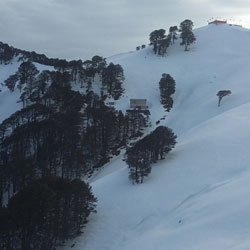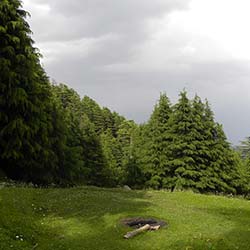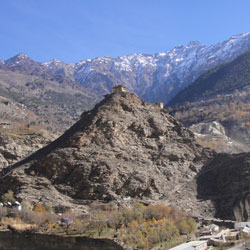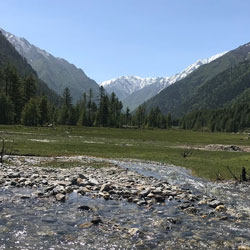
- Home
- Travel Packages
- Top Destination
-
Travel Attraction
By Category
Top Attraction

- Travel Agents
- Car Rentals
- Hotels

Shikari Devi Wildlife Sanctuary
About Shikari Devi Wildlife Sanctuary The Shikari Devi Wildlife Sanctuary is located in Mandi district in the state of Himachal Pradesh, India. It is a protected area known for its diverse flora and fauna and offers a tranquil escape into the wilderness. The sanctuary is named after the Shikari Devi temple, which is situated at the highest point in the sanctuary and is a popular pilgrimage site for devotees. Location and Geographical Overview The sanctuary is located at an altitude ranging from 1,800 to 3,400 meters above sea level. It covers an area of approximately 75 square kilometers and is surrounded by lush green forests and snow-capped mountains. The sanctuary is home to a variety of wildlife species and provides a natural habitat for them to thrive. Open and Closing Time The Shikari Devi Wildlife Sanctuary is open to visitors from sunrise to sunset. It is advisable to check the exact timings before planning your visit, as they may vary depending on the season. Entry Fee There is a nominal entry fee for visitors to enter the sanctuary. The fee helps in the conservation efforts and maintenance of the sanctuary. Visitors can pay the entry fee at the designated entry point before entering the sanctuary. Species-Flora/Fauna Availability The sanctuary is home to a diverse range of flora and fauna. Visitors can spot various species of trees, plants, birds, and animals while exploring the sanctuary. Some of the common wildlife species found in the sanctuary include barking deer, Himalayan black bear, leopard, and various bird species. Activities Performed Visitors can indulge in a variety of activities while exploring the sanctuary. Some of the popular activities include nature walks, bird watching, photography, and trekking. The sanctuary offers a serene environment for visitors to connect with nature and enjoy the beauty of the wilderness. Jeep Safari Charges For those looking to explore the sanctuary in a more comfortable and convenient way, jeep safaris are available. Visitors can book a jeep safari at the designated booking counter and enjoy a guided tour of the sanctuary at an additional cost. Age Criterion and Entry Fee The sanctuary has different entry fee criteria based on the age of visitors. Generally, there are separate entry fees for males, females, and children. It is recommended to check the age criteria and entry fee details before planning your visit to the sanctuary. Senior Citizen Facilities The sanctuary is equipped with facilities to cater to the needs of senior citizens. There are designated resting areas and benches where senior citizens can relax and enjoy the beauty of nature. Additionally, there are wheelchair-accessible paths for those with mobility challenges. Best Time to Visit The best time to visit the Shikari Devi Wildlife Sanctuary is during the summer months from April to June and the early autumn months from September to November. The weather is pleasant during these months, making it ideal for exploring the sanctuary and spotting wildlife. Nearby Places to Visit There are several other attractions near the Shikari Devi Wildlife Sanctuary that visitors can explore. Some of the popular nearby places include the Shikari Devi Temple, Janjehli Valley, and Kamrunag Lake. These attractions offer a glimpse into the rich cultural and natural heritage of the region. Vehicle Parking Facility Visitors traveling to the sanctuary by their vehicles can make use of the designated parking facilities available near the entry point. It is advisable to follow the parking regulations and park your vehicle in the designated areas to ensure a smooth flow of traffic and avoid any inconvenience. Rules and Regulations While visiting the Shikari Devi Wildlife Sanctuary, visitors are expected to follow certain rules and regulations to ensure the preservation of the sanctuary and the safety of wildlife. Some of the common rules include maintaining silence, not feeding the animals, not littering, and following the designated walking paths. How to Reach and Other Related Information The Shikari Devi Wildlife Sanctuary is easily accessible by road from Mandi town. Visitors can hire a taxi or use public transportation to reach the sanctuary. The nearest airport is located in Kullu, and the nearest railway station is in Jogindernagar. It is recommended to plan your visit in advance and check for any updates or changes in the timings and facilities available at the sanctuary. Overall, the Shikari Devi Wildlife Sanctuary offers a unique opportunity to experience the beauty of nature and wildlife in a serene and tranquil setting. Whether you are a nature lover, wildlife enthusiast, or simply looking for a peaceful getaway, the sanctuary has something to offer for everyone. Plan your visit to the sanctuary and immerse yourself in the natural wonders of Himachal Pradesh.
Explore More
About Kalatop Wildlife Sanctuary The Kalatop Wildlife Sanctuary is a popular tourist destination located in Dalhousie, Himachal Pradesh. It covers an area of approximately 30.69 square kilometers and is known for its diverse flora and fauna. The sanctuary is named after the Kalatop Rest House, which is a colonial-era building located within its premises. Location and Geographical Overview The Kalatop Wildlife Sanctuary is situated at an altitude of 1,250 meters to 2,680 meters above sea level. It is located at a distance of about 6 kilometers from Dalhousie and can be easily reached by road. The sanctuary is surrounded by dense forests of pine, deodar, and oak trees, making it a picturesque and tranquil place to visit. Open and Closing Time The Kalatop Wildlife Sanctuary is open to visitors from 9:00 AM to 5:00 PM every day of the week. It is advisable to visit during these hours to make the most of your trip and experience the wildlife and natural beauty of the sanctuary. Entry Fee There is no entry fee to visit the Kalatop Wildlife Sanctuary, making it a budget-friendly destination for nature lovers and wildlife enthusiasts. Visitors are only required to pay for specific activities or services they wish to avail during their visit. Species-Flora/Fauna Availability The sanctuary is home to a variety of flora and fauna species, including Himalayan black bear, leopard, deer, langur, jackal, and numerous bird species. The dense forests of the sanctuary also house a rich variety of plant life, making it a biodiversity hotspot in the region. Activities Performed Visitors to the Kalatop Wildlife Sanctuary can indulge in activities such as nature walks, bird watching, and wildlife spotting. The sanctuary also offers camping facilities for those who wish to spend a night amidst nature and experience the wilderness up close. Jeep Safari Charges Jeep safaris are available for visitors who want to explore the sanctuary and its wildlife from the comfort of a vehicle. The charges for jeep safaris vary depending on the duration and route chosen by the visitors. Age Criterion and Entry Fee There is no specific age criterion for visitors to enter the Kalatop Wildlife Sanctuary. However, entry fees may vary for male, female, and children visitors. The entry fee is typically nominal and affordable for all age groups. Senior Citizen Facilities The sanctuary offers facilities for senior citizens to ensure their comfort and safety during their visit. These may include accessible paths, seating areas, and assistance from staff members, making it an inclusive destination for visitors of all ages. Best Time to Visit The best time to visit the Kalatop Wildlife Sanctuary is during the summer months of March to June when the weather is pleasant and wildlife sightings are more frequent. The sanctuary is also open during the monsoon and winter seasons, offering unique experiences to visitors during these times. Nearby Places to Visit While visiting the Kalatop Wildlife Sanctuary, tourists can explore other nearby attractions in Dalhousie such as Khajjiar, Chamera Lake, Panchpula, and St. John's Church. These places offer a mix of natural beauty, adventure activities, and cultural experiences for visitors to enjoy. Vehicle Parking Facility The sanctuary provides parking facilities for visitors who wish to drive to the location. There are designated parking areas near the entrance of the sanctuary where visitors can safely park their vehicles and proceed to explore the area on foot. Rules and Regulations Visitors are required to adhere to certain rules and regulations while visiting the Kalatop Wildlife Sanctuary to ensure the safety of themselves and the wildlife. These may include maintaining silence, not feeding the animals, refraining from littering, and following the instructions of the sanctuary staff. How to Reach and Other Related Information The Kalatop Wildlife Sanctuary can be reached by road from Dalhousie, which is well-connected to major cities in Himachal Pradesh. Visitors can also hire private taxis or use public transport to reach the sanctuary. Accommodation options are available in Dalhousie for those who wish to stay overnight and explore the sanctuary at their leisure. Overall, the Kalatop Wildlife Sanctuary is a must-visit destination for nature lovers and wildlife enthusiasts looking to experience the beauty and serenity of the Himalayan region. With its diverse flora and fauna, picturesque landscapes, and numerous activities to enjoy, the sanctuary offers a memorable and enriching experience for all visitors.
Explore More
About Lipa-Asrang Sanctuary The Lipa-Asrang Sanctuary, located in Kinnaur district of Himachal Pradesh, is a protected area known for its rich biodiversity and stunning natural beauty. Spread over an area of approximately 30 square kilometers, the sanctuary is home to a variety of flora and fauna, making it a paradise for nature lovers and wildlife enthusiasts. Location and Geographical Overview The Lipa-Asrang Sanctuary is situated in the picturesque Kinnaur district of Himachal Pradesh, nestled amidst the majestic Himalayas. The sanctuary is located at an altitude ranging from 2,200 meters to 4,000 meters above sea level, offering stunning views of snow-capped peaks, lush valleys, and meandering rivers. Open and Closing Time The Lipa-Asrang Sanctuary is open to visitors from 9:00 AM to 5:00 PM every day, except on Mondays when it remains closed for maintenance activities. Entry Fee There is a nominal entry fee for visiting the Lipa-Asrang Sanctuary, with separate charges for Indian and foreign tourists. Visitors can purchase tickets at the entrance gate or online through the official website of the sanctuary. Species-Flora/Fauna Availability The sanctuary is home to a diverse range of flora and fauna, including rare and endangered species. Some of the commonly found animals in the sanctuary are Himalayan Black Bear, Snow Leopard, Blue Sheep, Musk Deer, and various species of birds and butterflies. The sanctuary also boasts of a rich variety of plant species, including pine, oak, deodar, rhododendron, and juniper. Activities Performed Visitors to the Lipa-Asrang Sanctuary can indulge in a number of activities such as nature walks, bird watching, photography, and trekking. Guided tours are also available for those interested in learning more about the flora and fauna of the sanctuary. Jeep Safari Charges For those looking to explore the sanctuary in a more adventurous way, jeep safaris are available at an additional cost. The safari takes visitors through the rugged terrains of the sanctuary, offering a chance to spot wildlife in their natural habitat. Age Criterion and Entry Fee The entry fee for the Lipa-Asrang Sanctuary varies based on the age and gender of the visitor. Children below the age of 5 are allowed free entry, while there are separate charges for male and female visitors. Senior citizens are also eligible for a discounted entry fee. Senior Citizen Facilities The sanctuary provides special facilities for senior citizens, including wheelchair access, resting areas, and guided assistance during the visit. Senior citizens can enjoy a leisurely stroll through the sanctuary while soaking in the serene atmosphere. Best Time to Visit The best time to visit the Lipa-Asrang Sanctuary is during the summer months from April to June when the weather is pleasant and the flora is in full bloom. The sanctuary is also open during the winter months, offering a unique opportunity to witness the snow-covered landscape and winter wildlife. Nearby Places to Visit Visitors to the Lipa-Asrang Sanctuary can explore other nearby attractions such as Kalpa, Sangla Valley, Chitkul, and Kamru Fort. These places offer a glimpse into the rich cultural heritage and scenic beauty of Kinnaur district. Vehicle Parking Facility For visitors traveling by their own vehicles, the Lipa-Asrang Sanctuary provides ample parking space near the entrance gate. Visitors can park their cars or bikes securely and proceed to explore the sanctuary on foot or through guided tours. Rules and Regulations While visiting the Lipa-Asrang Sanctuary, visitors are required to adhere to certain rules and regulations to ensure the safety of wildlife and maintain the sanctity of the environment. Littering, feeding animals, making loud noises, and damaging plant life are strictly prohibited within the sanctuary premises. How to Reach and Other Related Information The Lipa-Asrang Sanctuary is well-connected by road and can be reached easily from major towns in Himachal Pradesh. The nearest airport is in Shimla, approximately 240 kilometers away, while the nearest railway station is in Kalka, around 310 kilometers from the sanctuary. Accommodation options are available in nearby towns and villages for visitors looking to stay overnight and explore the sanctuary at their leisure. Overall, the Lipa-Asrang Sanctuary offers a unique opportunity to connect with nature, witness diverse wildlife, and immerse oneself in the tranquility of the Himalayan mountains. Whether you are a nature enthusiast, adventure seeker, or wildlife lover, a visit to this sanctuary is sure to leave you with unforgettable memories and a renewed appreciation for the wonders of the natural world.
Explore More
About Rakcham Chitkul Sanctuary Rakcham Chitkul Sanctuary is a stunning natural reserve located in the Kinnaur district of Himachal Pradesh, India. This sanctuary is known for its diverse flora and fauna, as well as its picturesque landscapes that attract nature enthusiasts and wildlife lovers from all around. The sanctuary is spread over an area of 30.98 square kilometers and is nestled between the villages of Rakcham and Chitkul, hence the name. Location and Geographical Overview Rakcham Chitkul Sanctuary is situated at an elevation ranging from 3200 to 5486 meters above sea level. It is surrounded by snow-capped mountains, lush green valleys, and gushing rivers, making it a paradise for nature lovers. The sanctuary is a part of the Western Himalayan range and is known for its unique ecosystem that supports a wide variety of plant and animal species. Open and Closing Time The sanctuary is open to visitors throughout the year, but the best time to visit is during the summer months from April to June and the autumn months from September to November. The sanctuary is closed during the winter months from December to February due to heavy snowfall and harsh weather conditions. Entry Fee There is a nominal entry fee for visitors entering the Rakcham Chitkul Sanctuary. The entry fee for adults is INR 50, and for children below the age of 12, the entry fee is INR 25. Senior citizens above the age of 60 can avail a discounted entry fee of INR 30. Species - Flora/Fauna Availability The sanctuary is home to a wide variety of plant and animal species. Some of the common flora found in the sanctuary include rhododendrons, oak trees, pine trees, and medicinal herbs. On the other hand, the sanctuary is also home to various species of wildlife such as snow leopards, Himalayan black bears, musk deer, and numerous bird species. Activities Performed Visitors can indulge in a range of activities within the sanctuary, such as nature walks, bird-watching, photography, camping, and trekking. The sanctuary also offers jeep safaris for visitors who want to explore the rugged terrains and spot wildlife in their natural habitat. Jeep Safari Charges The charges for a jeep safari in Rakcham Chitkul Sanctuary vary depending on the duration and route chosen. On average, the cost for a jeep safari ranges from INR 1500 to INR 3000 per person. Visitors can book jeep safaris through authorized tour operators or the sanctuary office. Age Criterion and Entry Fee Entry to the sanctuary is open to visitors of all ages. The entry fee varies for different age groups, with adults paying INR 50, children below 12 years paying INR 25, and senior citizens above 60 years paying INR 30. Children under the age of 5 are allowed free entry. Senior Citizen Facilities Rakcham Chitkul Sanctuary offers special facilities for senior citizens to ensure their comfort and safety during their visit. These facilities include designated seating areas, easy access to restrooms, and assistance from sanctuary staff if needed. Best Time to Visit The best time to visit Rakcham Chitkul Sanctuary is during the summer months from April to June and the autumn months from September to November. During these months, the weather is pleasant, and visitors can witness the lush greenery and blooming flowers in the sanctuary. Nearby Places to Visit There are several tourist attractions near Rakcham Chitkul Sanctuary that visitors can explore. Some of the popular places to visit include Chitkul Village, Kamru Fort, Nako Lake, and the Kalpa Valley. These attractions offer a glimpse into the rich culture and heritage of the region. Vehicle Parking Facility Rakcham Chitkul Sanctuary has designated parking areas for visitors who bring their vehicles. The parking facilities are well-maintained and secure, providing visitors with a hassle-free experience during their visit to the sanctuary. Rules and Regulations Visitors to Rakcham Chitkul Sanctuary are required to follow certain rules and regulations to ensure the safety of the wildlife and maintain the pristine environment of the sanctuary. Some of the rules include not littering, not feeding the animals, and respecting the wildlife and their habitat. How to Reach and Other Related Information Rakcham Chitkul Sanctuary is easily accessible by road from major cities like Shimla and Chandigarh. Visitors can hire taxis or use public transport to reach the sanctuary. The nearest airport is in Shimla, and the nearest railway station is in Kalka. Overall, Rakcham Chitkul Sanctuary is a must-visit destination for nature lovers and wildlife enthusiasts looking to explore the natural beauty of Himachal Pradesh. With its diverse flora and fauna, stunning landscapes, and range of activities, the sanctuary offers a memorable experience for visitors of all ages.
Explore MoreHimachal 9 Days - 8 Nights Tour Package
9 Days/ 8 Night
Dalhousie - Khajjiar - Kufri - Kullu - Manali - Shimla - Dharamshala
5 Night 6 Days Shimla - Manali Tour Ex - Delhi
6 Days/ 5 Night
Kufri - Kullu - Manali - Manikaran - Shimla
Blissful Kullu - Manali Tour Package
4 Days/ 3 Night
Manali
Jibhi - Tirthan Valley Trip Package From Delhi
4 Days/ 3 Night
Jibhi